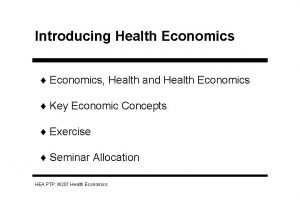Chapter 19 Health Care Economics Copyright 2013 Wolters

















- Slides: 17

Chapter 19: Health Care Economics Copyright © 2013 Wolters Kluwer Health | Lippincott Williams & Wilkins

Differences Among Health Care Institutions • Services Offered by Health Care Facilities – Emergency room treatment – Community health education classes and materials – Health screening services – Clinical services – Medical education for physicians, nurses, & others – Financial contributions to community organizations – Coordination of events & donations for community organizations Copyright © 2013 Wolters Kluwer Health | Lippincott Williams & Wilkins

Differences Among Health Care Institutions (cont’d) • Voluntary Nonprofit Institutions – Exempt from federal, state, & local taxes – Must be operated for charitable purposes Copyright © 2013 Wolters Kluwer Health | Lippincott Williams & Wilkins

Differences Among Health Care Institutions (cont’d) • Proprietary Institutions – For-profit health care facilities – Owned by a corporation – Often consist of a chain of: • Hospitals • Nursing homes • Outpatient facilities – Pay local, state, & federal taxes Copyright © 2013 Wolters Kluwer Health | Lippincott Williams & Wilkins

Differences Among Health Care Institutions (cont’d) • Government Institutions – Funded primarily by local, state, or federal sources – Examples: • Military treatment facilities • Veterans Affairs (VA) hospitals • Public or government-funded hospitals • State mental hospitals • State rehabilitation facilities Copyright © 2013 Wolters Kluwer Health | Lippincott Williams & Wilkins

Health Care Payment Methods • Private Insurance – Employment-based, group plans – Offered by insurance companies – Employer pays part of premium; employee pays rest – Trend: employers shifting costs to employee Copyright © 2013 Wolters Kluwer Health | Lippincott Williams & Wilkins

Health Care Payment Methods (cont’d) • Private Insurance (cont’d) – Premium: monthly amount the insured pays for policy – Deductible: amount the insured must pay before benefits start – Co-insurance: insured shares a portion (10 -30%) of costs – Co-pay: flat fee paid by the insured per service Copyright © 2013 Wolters Kluwer Health | Lippincott Williams & Wilkins

Health Care Payment Methods (cont’d) • Direct Payment – Patients pay for health care with their own money – “Shopping around”: • Creates competition • Drives down prices Copyright © 2013 Wolters Kluwer Health | Lippincott Williams & Wilkins

Health Care Payment Methods (cont’d) • Government Plans: Medicare – Health care program for older Americans – Established in 1965 by amendments to Social Security Act – Expanded in 1972 to include disabled & their dependents – Converted in 1983 to prospective payment system Copyright © 2013 Wolters Kluwer Health | Lippincott Williams & Wilkins

Health Care Payment Methods (cont’d) • Government Plans: Medicare (cont’d) – Part A: inpatient care costs (no monthly premium) – Part B: outpatient costs (monthly premium) – Part C: extra benefits – Part D: prescription drug coverage Copyright © 2013 Wolters Kluwer Health | Lippincott Williams & Wilkins

Health Care Payment Methods (cont’d) • Government Plans: Medicaid – Health insurance for low-income & disabled people – Established in 1965 as part of Social Security Act Copyright © 2013 Wolters Kluwer Health | Lippincott Williams & Wilkins

Health Care Payment Methods (cont’d) • Government Plans for Military Personnel – TRICARE Copyright © 2013 Wolters Kluwer Health | Lippincott Williams & Wilkins

Health Care Payment Methods (cont’d) • New Government Programs – SCHIP • State Children’s Health Insurance Program • Established in 1997 • Expired in 2007 – CHIRPA • Children’s Health Insurance Program Reauthorization Act • Passed in 2009 Copyright © 2013 Wolters Kluwer Health | Lippincott Williams & Wilkins

Managed Care • Health care providers (gatekeepers) manage access to care • Goal: contain costs • In-network vs. out-of-network providers • Utilization review Copyright © 2013 Wolters Kluwer Health | Lippincott Williams & Wilkins

Managed Care (cont’d) • Types of Plans – Health Maintenance Organization (HMO) plan – Preferred Provider Organization (PPO) plan – Point of Service (POS) plan Copyright © 2013 Wolters Kluwer Health | Lippincott Williams & Wilkins

Cost Containment Measures • Diagnostic related group (DRG) classification system • Patients assigned to DRG based on: – Diagnosis – Other demographic info • Health care paid in standard fees, regardless of actual costs • Offers incentive to hospitals for operating more efficiently Copyright © 2013 Wolters Kluwer Health | Lippincott Williams & Wilkins

Utilizing Resources Efficiently • Responsibility of all health care professionals • Conscientious time management • Electronic documentation Copyright © 2013 Wolters Kluwer Health | Lippincott Williams & Wilkins
 Wolters kluwer health
Wolters kluwer health Lippincott
Lippincott Chemical synapse
Chemical synapse Wolters kluwer health
Wolters kluwer health Wolters kluwer health
Wolters kluwer health Wolters kluwer health
Wolters kluwer health Wolters kluwer health
Wolters kluwer health Wolters kluwer health
Wolters kluwer health Wolters kluwer health lippincott williams & wilkins
Wolters kluwer health lippincott williams & wilkins Copyright 2013
Copyright 2013 Levels of health care primary secondary tertiary
Levels of health care primary secondary tertiary Wolters kluwer
Wolters kluwer Wolters kluwer
Wolters kluwer Synaptic integration
Synaptic integration Wolters kluwer
Wolters kluwer Wolters kluwer
Wolters kluwer Chapter 25 assessment of cardiovascular function
Chapter 25 assessment of cardiovascular function Virchow's triad
Virchow's triad

































